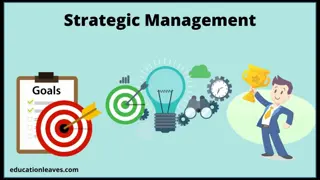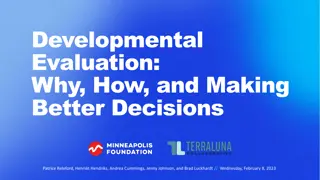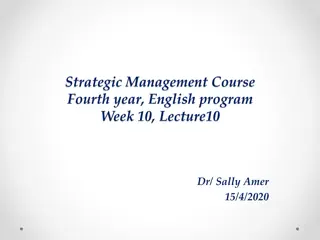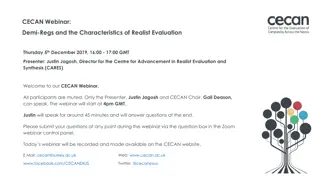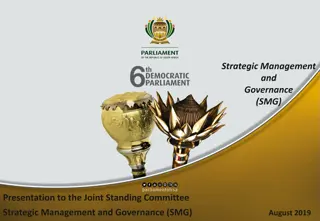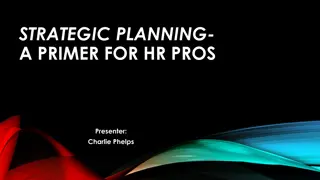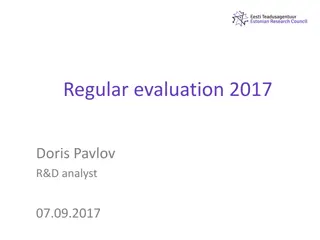Strategic Management: Strategy Review and Evaluation
This chapter delves into the critical process of strategy review, evaluation, and control in strategic management. It covers the nature of strategy evaluation, effective evaluation systems, contingency planning, auditing, using computers for evaluation, and guidelines for effective strategic management. Understanding and implementing these concepts is crucial for organizations to adapt and thrive in dynamic environments.
Download Presentation

Please find below an Image/Link to download the presentation.
The content on the website is provided AS IS for your information and personal use only. It may not be sold, licensed, or shared on other websites without obtaining consent from the author. Download presentation by click this link. If you encounter any issues during the download, it is possible that the publisher has removed the file from their server.
E N D
Presentation Transcript
Chapter 9: Strategy Review, Evaluation and Control Strategic Management: Concepts and Cases. 9th edition Fred R. David PowerPoint Slides by Anthony F. Chelte Western New England College Ch 9-1 Fred R. David Prentice Hall
Chapter Outline The Nature of Strategy Evaluation A Strategy-Evaluation Framework Published Sources of Strategy- Evaluation Information Ch 9-2 Fred R. David Prentice Hall
Chapter Outline Characteristics of an Effective Evaluation System Contingency Planning Auditing Ch 9-3 Fred R. David Prentice Hall
Chapter Outline Using Computers to Evaluate Strategy Guidelines for Effective Strategic Management Ch 9-4 Fred R. David Prentice Hall
Implementing Strategies Organizations are most vulnerable when they are at the peak of their success. -- R.T. Lenz Ch 9-5 Fred R. David Prentice Hall
Strategy Review, Evaluation & Control Systematic Review, Evaluation & Control Strategies become obsolete Internal environments are dynamic External environments are dynamic Ch 9-6 Fred R. David Prentice Hall
Strategy Evaluation Strategy evaluation is vital to the organization s well-being Alert management to potential or actual problems in a timely fashion Erroneous strategic decisions can have severe negative impact on organizations Ch 9-7 Fred R. David Prentice Hall
Strategy Evaluation 3 Basic Activities 1. Examining the underlying bases of a firms strategy 2. Comparing expected to actual results 3. Corrective actions to ensure performance conforms to plans Ch 9-8 Fred R. David Prentice Hall
Strategy Evaluation Strategy evaluation Complex and sensitive undertaking Overemphasis can be costly and counterproductive Ch 9-9 Fred R. David Prentice Hall
Strategy Evaluation In many organizations, evaluation is an appraisal of performance Have assets increased? Increase in profitability? Increase in sales? Increase in productivity? Profit margins, ROI and EPS ratios increased? Ch 9-10 Fred R. David Prentice Hall
Strategy Evaluation Four Criteria (Richard Rummelt): Consistency Consonance Feasibility Advantage Ch 9-11 Fred R. David Prentice Hall
Rummelts Criteria Consistency Strategy should not present inconsistent goals and policies. Conflict and interdepartmental bickering symptomatic of managerial disorder and strategic inconsistency Ch 9-12 Fred R. David Prentice Hall
Rummelts Criteria Consonance Need for strategies to examine sets of trends Adaptive response to external environment Trends are results of interactions among other trends Ch 9-13 Fred R. David Prentice Hall
Rummelts Criteria Feasibility Neither overtax resources or create unsolvable subproblems Organizations must demonstrate the abilities, competencies, skills and talents to carry out a given strategy Ch 9-14 Fred R. David Prentice Hall
Rummelts Criteria Advantage Creation or maintenance of competitive advantage Superiority in resources, skills, or position Ch 9-15 Fred R. David Prentice Hall
Strategy Evaluation Difficulty in strategy evaluation 1. Increase in environment s complexity 2. Difficulty predicting future with accuracy 3. Increasing number of variables Ch 9-16 Fred R. David Prentice Hall
Strategy Evaluation Difficulty in strategy evaluation 4. Rate of obsolescence of plans 5. Domestic and global events 6. Decreasing time span for planning certainty Ch 9-17 Fred R. David Prentice Hall
Process of Strategy Evaluation Strategy evaluation should Initiative managerial questioning Trigger review of objectives and values Stimulate creativity in generating alternatives Ch 9-18 Fred R. David Prentice Hall
Reviewing Bases of Strategy Review of underlying bases of strategy Develop revised EFE Matrix Develop revised IFE Matrix Ch 9-19 Fred R. David Prentice Hall
Reviewing Bases of Strategy Review effectiveness of strategy 1. Competitors reaction to strategy 2. Competitors change in strategy 3. Competitors changes in strengths and weaknesses 4. Reasons for competitors strategic change Ch 9-20 Fred R. David Prentice Hall
Reviewing Bases of Strategy Review effectiveness of strategy 5. Reasons for competitors successful strategies 6. Competitors present market positions and profitability 7. Potential for competitor retaliation 8. Potential for cooperation with competitors Ch 9-21 Fred R. David Prentice Hall
Reviewing Bases of Strategy Monitor Threats and Opportunities and Weaknesses and Strengths Are our internal strengths still strengths? Have we added additional strengths? Are our weaknesses still weaknesses? Have we other internal weaknesses? Ch 9-22 Fred R. David Prentice Hall
Reviewing Bases of Strategy Monitor Threats and Opportunities and Weaknesses and Strengths Are opportunities still opportunities? Other external opportunities? Are threats still threats? Are there other threats? Are we vulnerable to a hostile takeover? Ch 9-23 Fred R. David Prentice Hall
Evaluation Framework I.Review Underlying Bases Yes Differences? NO III. Take Corrective Actions II. Measure Firm Performance Yes Differences? NO Continue present course Ch 9-24 Fred R. David Prentice Hall
Measuring Organizational Performance Comparing expected to actual results Investigating deviations from plan Evaluating individual performance Progress toward stated objectives Ch 9-25 Fred R. David Prentice Hall
Measuring Organizational Performance Quantitative criteria for strategy evaluation Financial Ratios: Compare performance over different periods Compare performance to competitors Compare performance to industry averages Ch 9-26 Fred R. David Prentice Hall
Measuring Organizational Performance Key Financial Ratios Return on investment Return on equity Profit margin Market share Ch 9-27 Fred R. David Prentice Hall
Measuring Organizational Performance Key Financial Ratios Debt to equity Earnings per share Sales growth Asset growth Ch 9-28 Fred R. David Prentice Hall
Measuring Organizational Performance Qualitative evaluation of strategy - Internal consistency of strategy Consistency of strategy with environment Strategy appropriate in view of resources Acceptable degree of risk Appropriate time frame Workability of the strategy Ch 9-29 Fred R. David Prentice Hall
Characteristics of Evaluation Basic requirements for effective strategy evaluation Economical Meaningful Generate useful information Timely information Provide a true picture of what is happening Ch 9-30 Fred R. David Prentice Hall
Strategy-Evaluation Assessment Matrix Have major changes occurred in the firm s internal strategic position? Have major changes occurred in the firm s external strategic position? Has the firm progressed satisfactorily toward achieving its stated objectives? Result No No No Corrective actions Yes Yes Yes Corrective actions Yes Yes No Corrective actions Yes No Yes Corrective actions Yes No No Corrective actions No Yes Yes Corrective actions No Yes No Corrective actions No No Yes Continue course Ch 9-31 Fred R. David Prentice Hall
Balanced Scorecard Kaplan and Norton s scenario Imagine entering the cockpit of a modern jet airplane and seeing only a single instrument there. How would you feel about boarding the plane after the following conversation with the pilot? Q: I am surprised to see you operating the plane with only a single instrument. What does it measure? A: Airspeed. I m really working on airspeed this flight. Q: That s good. Airspeed certainly seems important. But what about altitude? Would not an altimeter be helpful? A: I worked on the altitude for the last few flights and I have gotten pretty good on it. Now I have to concentrate on proper airspeed. Q: But I notice you don t have a fuel gauge. Wouldn t that be useful? A: You are right; fuel is significant, but I can t concentrate on doing too many things well at the same time. So on this flight, I m focusing on airspeed. Once I get to be excellent at airspeed, as well as altitude, I intend to concentrate on fuel consumption on the next set of flights.
Balanced Scorecard The analogy with business is not that far fetched. Focusing on one thing in an excellent manner ignoring all others is a disaster for air flight as well as businesses.
Balanced Scorecard The purpose of balanced scorecard is to: translate strategy into measures that uniquely communicate your vision to the organization
Balanced Scorecard The balanced scorecard consists of four perspectives: Financial perspective: Ultimate results that the business provide to its shareholders i.e revenue growth, ROI. Internal perspective: Key Internal Processes i.e quality levels, productivity, cycle time. Customer perspective: Focus on customer s needs and satisfaction i.e Service level, satisfaction ratings, repeat business. Innovation and learning perspectives: Focus on Organization s people and infrastructure i.e. employee satisfaction, market innovation, skill development
Balanced Scorecard A good balanced Scorecard contains both leading and lagging measures and indicators. Lagging measures (outcomes) tell what has happened; leading measures (performance drivers) predict what will happen.
Contingency Planning Premise of sound strategic management Planning to deal with unfavorable and favorable events before they occur. Ch 9-37 Fred R. David Prentice Hall
Contingency Planning Contingency Planning Alternative plans that can be put into effect if certain key events do not occur as expected Ch 9-38 Fred R. David Prentice Hall
Auditing Financial audits to determine correspondence between assertions based on strategic plans and established criteria Environmental audits to insure sound and safe practices Ch 9-39 Fred R. David Prentice Hall
Key Terms Advantage Auditing Consistency Consonance Contingency Plans Corporate Agility Feasibility Ch 9-40 Fred R. David Prentice Hall
Key Terms Future Shock Management by Wandering Around Measuring Organizational Performance Planning Process Audit (PPA) Reviewing the Underlying Bases of an Organization s Strategy Ch 9-41 Fred R. David Prentice Hall
Key Terms Revised EFE Matrix Revised IFE Matrix Taking Corrective Actions Ch 9-42 Fred R. David Prentice Hall






